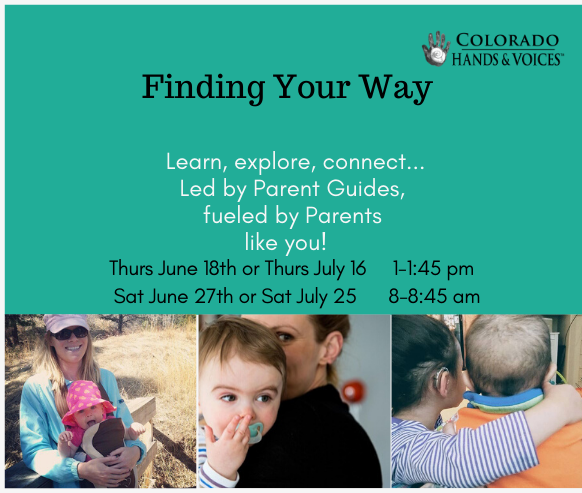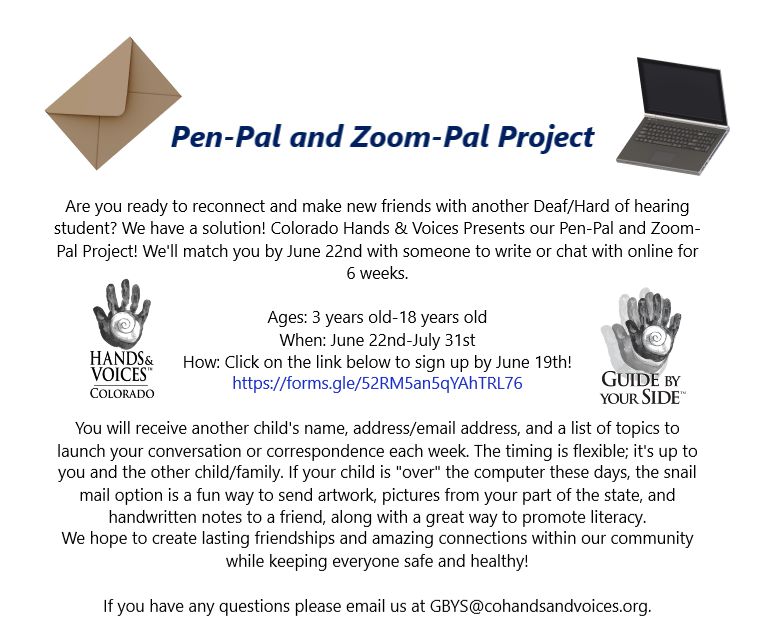As Matthew grew, Erin and Jeff knew he would need some extra help to meet his milestones. As he was learning to walk, he needed support from a walker to stay balanced while on the move. Matthew received his first Cochlear Implant when he was one and a half, and then another when he was almost four. When Matthew was 3, he was also diagnosed with severe Autism. His mom notes, “There are so many things we have to take into consideration for Matthew. Speech Therapy is a challenge because he needs so much sensory input during therapy. Trying to keep him on track with his autism is challenging. Every week we have PT, OT, and Speech, along with two therapies to help with his autistic behaviors. We did Sign Language and Auditory Verbal Therapy for a while as well. What he needs on a day-to-day basis always changes. He is also just a little boy trying to keep up with his big brother.”
Archives for June 2020
Pen-Pal and Zoom-Pal Project
New to the Journey? Finding Your Way
New to the Journey?
Learn, Explore and Connect with other parents! These 45-minute Zoom sessions are led by Parent Guides to help parents connect with each other and learn more about raising a child who is deaf/hard of hearing. You don’t know what you don’t know – yet!
If you are new to the journey, this is your place.
Questions? gbys@cohandsandvoices.org
RSVP for one or more sessions here:
https://forms.gle/JpeYMDDGoDzG9QCt9

A Journey of Growth and Understanding
|
A Journey of Growth and Understanding
By Kelly Fernandez-Kroyer
|
 |
|
I live with my husband Sean and our two sons, Ethan and Noah in the north Denver metro area. Both of our children decided to make their entrance into this world early at 32 weeks. After the premature birth of Ethan, we did our due diligence to determine why he had stopped growing in utero and what we needed to do to prevent this from happening in any future pregnancies. Fast forward two years later, we were ecstatic to make Ethan a big brother. This second pregnancy was eventful from the beginning. I had a new diagnosis– a blood clotting disorder–which doctors believe caused Ethan to stop growing. We learned that the best solution to prevent premature birth again was to start blood thinners at 8 weeks gestation. As the pregnancy continued, I was eventually transferred to Maternal-Fetal Medicine because the same symptoms were presenting again. At 29 weeks, I started hospital bedrest to give this son as long as possible in utero. We planned to name this little one Noah. Further interventions were unsuccessful and Noah was delivered at 32 weeks. Being premature, Noah was immediately transferred to the NICU where he would stay for the next 20 days.
When we received word that the NICU was getting ready to release Noah and that all we needed to complete was the carseat test, we were elated. I remember coming in that morning and seeing Noah’s hearing screen certificate saying he had passed. I thought nothing more of it because we knew that there was no history of hearing loss in either of our families.
A Quest For Answers
Because of Noah’s prematurity and at the suggestion of our pediatrician who noticed that Noah wasn’t meeting developmental milestones, we received a referral to Early Intervention. Hearing and vision were part of the battery of tests to be completed. I went with Noah to these evaluations thinking that hearing testing was just a formality because he had passed his hearing screening at birth. He was six-months-old when we got our first “refer” in his right ear during this OAE (otoacoustic emissions) testing. We were told that we should follow back up with them in 6 months to rescreen. We returned in 6 months and again received another refer. Now at a year old, we were informed we should follow up with an ENT to see if we could get further answers on Noah’s hearing. We went to that appointment where the doctor ran another OAE and again, received a refer result. The ENT scheduled us to see the audiologist the following week. His first test in the sound booth with an audiologist was not reliable and was incomplete because our one-year-old boy was not interested. We scheduled more exams, but finally scheduled a sedated ABR (auditory brainstem response) test to get better results. We would learn that Noah’s ABR showed that he had unilateral sensorineural hearing loss at a moderate level across all frequencies.
We thought we had finally received the answers we needed to take the necessary steps to ensure that Noah would be as successful as possible. We were not quite there. Because his previous tests had been so unreliable, his audiologist wanted to complete yet another booth test to ensure all of the results were in agreement with each other. For the next 6 months, Noah’s results seemed to fluctuate. He was responding to sounds that his ABR told us he shouldn’t hear. Being an 18-month-old boy, we also didn’t get cooperation from him at most appointments. Finally, it was decided we should schedule another ABR nine months after his first one had been completed.
We came into this appointment expecting that we would finally get confirmation that his results were similar to that first ABR. After the test had been completed, we were informed that Noah’s results now showed that he did have UHL but that this loss was only in the lower frequencies (500 Hz and 1000 Hz). The ABR showed that his results in the upper frequencies were within the normal range. We were informed that he had reverse-slope hearing loss and further that his hearing loss was not sensorineural but conductive, or related to his middle ear, instead. We were in shock but determined more than ever to do whatever needed to be done to ensure that he could be as successful as possible.
It has been four years since we received that diagnosis and subsequent hearing tests have aligned with his last full evaluation showing UHL. We made the decision to pursue amplification which has proved successful in assisting Noah to reach his full potential. I look back on the emotions that I first felt when we received Noah’s diagnosis. After the shock had worn off, which I admit took longer than I expected, I decided that his hearing loss was not going to affect the person he was going to become. Although we began receiving early intervention services later than we would have liked due to the length of time it took to confirm his results, I am thankful that we were able to provide him with the therapies he needed to assist him in his development. I made it a priority to become as informed as possible on what my son’s identification with UHL meant for him.
I immersed him in as many programs as I could possibly find to make sure that he knew that he wasn’t alone; that there were other children just like him. I have been involved in a UHL focus group and had the opportunity to attend quite a few events and workshops through CO H&V, and am excited that we have both a CO UHL page and a Facebook page through Hands & Voices HQ. I have met many incredible people along the way who have shown me that my son’s hearing loss is not going to prevent him from being the best he can be.
I am thankful that I can share the same hope that I was provided; that being deaf or hard of hearing doesn’t lessen a person’s chance of reaching their fullest potential and that there is a strong support network available for as long as needed. Through this journey, I have learned that success is something that Noah will define for himself. There are no limitations on what he is capable of achieving.
|



Recent Comments